Imagining Paris: Gertrude Stein, Picasso, Proust & More
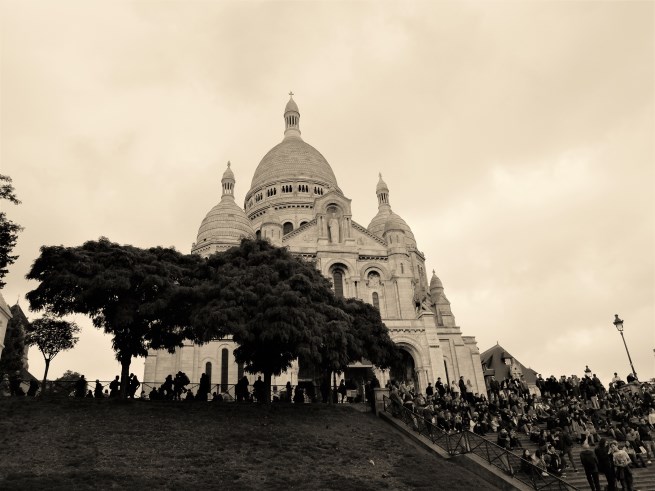
- SUBSCRIBE
- ALREADY SUBSCRIBED?
BECOME A BONJOUR PARIS MEMBER
Gain full access to our collection of over 5,000 articles and bring the City of Light into your life. Just 60 USD per year.
Find out why you should become a member here.
Sign in
Fill in your credentials below.

Black & white Paris, photo © Theo Gittens
Gertrude
Gertrude Stein walked up my street! Okay, not recently, not any time this century, but she did indeed stroll or stride (but not wander, Gertrude would not wander) up the hill. I know she did because in An Autobiography of Alice B Toklas she mentions walking up rue Lepic on her way to visit Picasso at Bateau Lavoir, which means she must have at least crossed my rue on her way. She visited him a number of times – sometimes to have her portrait painted, and one time, simply going to a party at his place. (I’m off to Pablo’s for a party, she might have said.) Perhaps, on a sunny afternoon after a good morning’s work, Pablo walked back down the hill with her chatting about the price of cherries. She was stout and probably puffed a bit.

Portrait of Gertrude Stein by Pablo Picasso,1906. Photo by Sharon Mollerus
I walk up rue Lepic and as I put each foot down I say to myself, this is where Ms Stein put her foot, this is where Picasso put his. I am literally walking in their footsteps, magically keeping myself going in the right direction.
Imagining Paris
I live in a Paris created for me by writers – and to a lesser extent, painters and film-makers. Who can imagine what it would be like to see Paris innocently – to see it without having read about it, seen it represented, first? For everyone except those born here, and perhaps even for them, Paris is first and always a city inscribed, a city which can only be seen through a fine lace of words and images. I suppose each of us who have come here to visit or to live has a slightly different lace, each more or less literary, painterly or cinematic. Mine is an odd, old-fashioned mixture of 19th and early 20th century French and American styles patterned by such lace-makers as Marcel Proust, Guy de Maupassant, Gustav Flaubert, Simone de Beauvoir, Anais Nin, Henry Miller, Ernest Hemingway, Henry James, Edith Wharton.
Proust
I had already been to Paris twice before I began Proust (we all begin Proust – I have yet to meet the proud and happy soul who has truthfully finished, skipping no paragraphs at all in À La Recherche du Temps Perdu), and so I already had an appreciation of the sensual feast of the city – I thought. But Proust’s intense re-creation of his world – you really have to get to the second book before Paris really kicks in – made me feel as if I had previously been ‘living with my being reduced to a minimum’ (to slightly misquote Marcel). Reading him is like taking a draught of some consciousness-enhancing drug – a kind of literary LSD. Rooms, buildings, streets, clothes, bodies, glow with a physical reality so intricately made on the page, that even after a small dose (and, to be honest, small doses are all my weak constitution can handle), my eyes feel seared open.
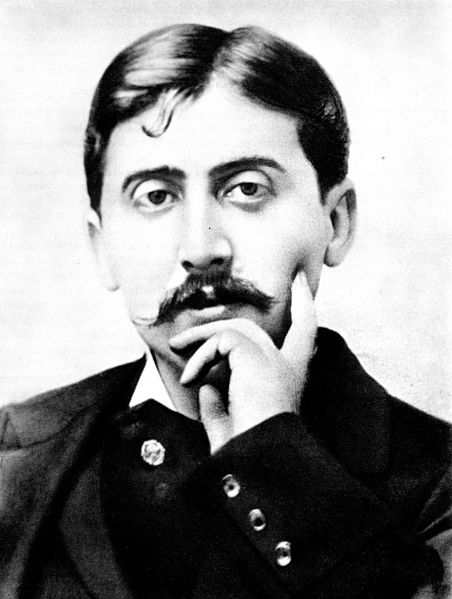
Proust in 1895, photo by Otto Wegener
It’s not so much that I see the world he created – it mostly doesn’t exist any more, but he does perform the far greater magic of waking me up to the overwhelming reality of being here and now in Paris.
Sartre and de Beauvoir
Like most people I read Jean-Paul and Simone in my twenties. They gave me not the streets or cafes or even the people of this city, no gritty realism from them, but the mindscape, the deeps valleys and sheer cliffs of thought. Their essays and their novels draw with fine strong lines a territory where Being is an idea constructed in every moment over the abyss of Nothingness. They constructed for me the world of the intello, a world which, despite occasional declarations to the contrary, is still evident if the number of bookshops per street in Paris is any indication of the intellectual life of a city. (Although I did see in the back streets of the 6th a bookshop selling second-hand books by weight – a kilo for five euros, was it?)
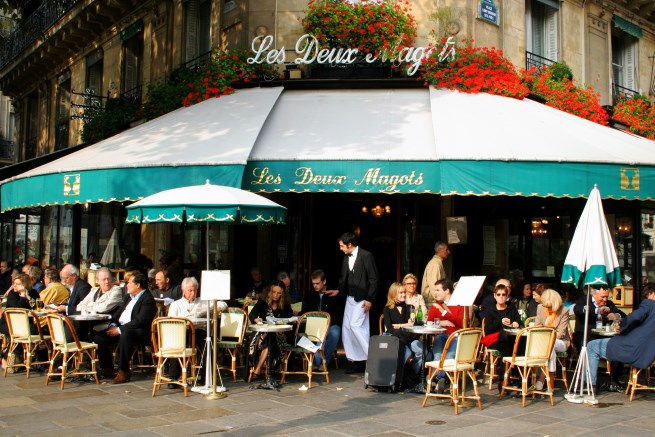
Les Deux Magots, photo by Roboppy
Of course I sat down in Les Deux Magots and ordered a coffee and wondered at which table the Gaze of the Other gave Sartre his Being until I was given my addition and found I was providing the hourly wage for the waiter all on my own. Paris café owners are not bereft of abstract thought when it comes to the relationship between intello groupies and the price of a cup of coffee.
Ernest
I was discouraged from reading Hemingway at university. The world had moved on – we were reading women writers – Jean Rhys and Gertrude Stein amongst them – and by the time I finally read his novels and then A Moveable Feast I had already lived here for a few months. Hemingway writes deceptively simple stories about daily events – people in his world do eat and drink (at La Closerie des Lilas) and think about things other than Love or Art. I remember his description of the disappointment of a false spring one year (don’t know why it struck me but I guess we all want spring to come before it’s ready) and then – and who knows why he mentioned this – that his wife had discovered a pillow under the small of the back gave a good angle for love-making. (I’ve tried it a few times – she must have had a different type of pillow).
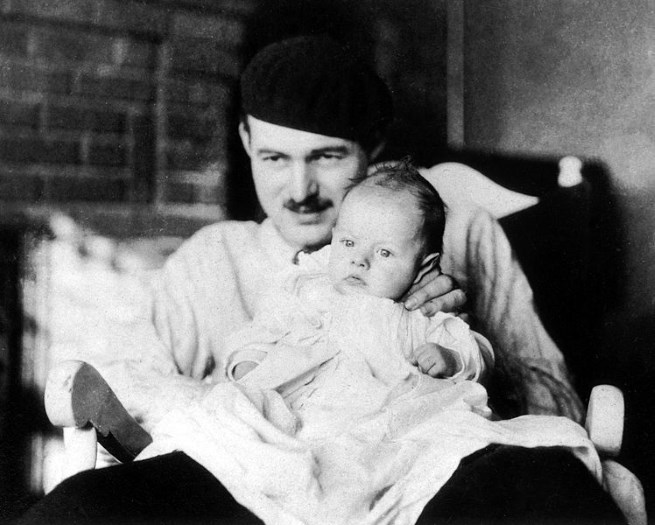
Hemingway and Bumby, Paris 1927, Photo: Paris Years, 1922-1930
There is a difference in adding to the myth once you are here – it is like hearing new stories about your lover. You can compare them now to the reality, and if you are still in love, it only increases the shine in your eyes. I know I will be heading off soon for a nonchalant whisky at La Closerie des Lilas (with a wallet full of euros).
Anais and Henry
There was a year when I read all the Journals of Anais Nin (so did all the women in my share-house) while my boyfriend tackled Henry Miller. We recited extracts aloud to each other, weaving a world we could both live in away from the ordinary streets of our antipodean city. The ateliers, house-boats, rainy streets, smoky cafes, tortured poets and passionate love affairs created a bohemian world which seemed impossible to be able to exist under our sunny skies. This was the Paris dedicated to art, to literature, to creativity where no one had anything but scorn for safety. This was the Paris which I carried around in my head for years, photographed in Cartier-Bresson black and white. I have to admit, despite an impatience with self-conscious, self-absorbed ‘artistes’, I am still a little disconcerted everytime I see an ordinary sensible advertisment for mattresses or Health insurance in the Metro. Part of me still believes everyone in Paris is living the Life of Art.
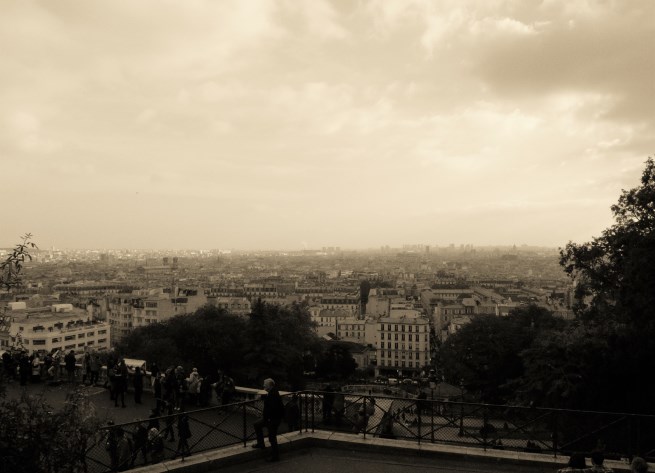
The view from Montmartre, photo © Theo Gittens
Imagining Paris
At present I live on the fifth floor (sans ascenseur) above a hair-dressing salon and up the road from a small seedy bar called Le Temps Perdue. I suspect the name refers to a lost time that has very little to do with madeleine cakes, but I still like walking past it every so often on my way to the office supplies shop where I buy paper and folders and printer ink. I carry them home, take a small dose of Marcel, then sit down at the computer, ready to begin making my own Parisian lace.
This article was originally published as ‘In Gerturde’s Footsteps’ in the travel section of The Melbourne Age
Lead photo credit : Sacré-Coeur atop Montmartre, photo © Theo Gittens



REPLY
REPLY
REPLY